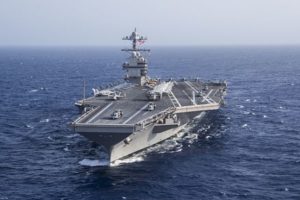The head of Naval Air Forces Atlantic recently said he expects the latest aircraft carrier, the USS Gerald R. Ford (CVN-78), to be ready for its first deployment in 2022.
During the Virtual Tailhook 2020 conference on Sept. 12, Rear Adm. John Meier said the Navy is focusing on building in reliability to the carrier’s systems before the ship is ready to be deployed.

“Right now the issue I think that we’re working closely on is building out of the gate reliability…is making sure the Electromagnetic Aircraft Launch System (EMALS) and Advanced Arresting Gear (AAG) has the right sparing, the right parts, the right equipment there in the event that something breaks,” Meir said.
“But, also, the right procedures and methodologies so that those things don’t break. So we’re still not where we want to be there but we have made great strides, we continue to get better, every aspect and every at sea period with Ford.”
Meir said the ship is “on track for the first deployment to be in ‘22” and said he is working closely with the 2nd Fleet and all the stakeholders in Program Executive Office Carriers “to make sure that she is materially ready.”
In his role now in the Ford team as supporting commander, from an equipping, training, and manning perspective, he is to give the Chief of Naval Operations and Fleet Forces commander the ability to make a decision on that deployment.
“Our job is to put her into that position. I’m confident we’ll be there.”
Meir also noted the Ford “has just been a workhorse here for us on the East Coast” in training new naval aviators in the Fleet Replacement Squadron (FRS). Previously, nearly all of that training work had shifted to the West Coast.
He admitted while the ship does not have all the Advanced Weapons Elevators yet, they have “made great progress” and he believes “we’re at I think a very good path for that.”
Ford is currently in the middle of an 18-month Post-Delivery Test and Trials (PDT&T) period that includes 11 at-sea underway periods. Meir said the ship is currently underway now and it started this period early due to COVID-19 restrictions and leadership decided they could best prepare those restrictions at sea.
PDT&T is due to be finished in the second quarter of fiscal year 2021 followed by full ship shock trials in the third quarter of 2021. The next step will be a planned incremental availability to repair and maintain shock trial impacts and any remaining issues before the initial deployment.
In July, the Navy certified the second lower sage and sixth overall Advanced Weapons Elevator (AWE). The Lower Stage Weapons Elevators (LSWEs) are designed to move more ordnance from the ship’s magazines to the flight deck (Defense Daily, July 23).
The Navy certified the first LSWE and fifth overall AWE in April (Defense Daily, April 23).
The long-delayed AWEs are a new technology designed to move ordnance throughout the ship more quickly, enhance carrying capacity, and reduce manning, maintenance and total ownership costs.
In April, the Navy’s top acquisition official, James Geurts, said the service expects all 11 AWEs to be ready and certified by the time of the shock trials (Defense Daily, April 17).
The Ford-class along with the AWEs are built by Huntington Ingalls Industries [HII].